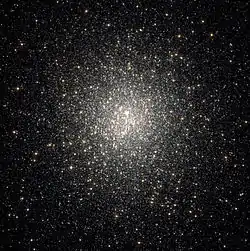Gaia Sausage
The Gaia Sausage is the remains of a dwarf galaxy, the Sausage Galaxy, or Gaia-Enceladus-Sausage, or Gaia-Enceladus, that merged with the Milky Way about 8–11 billion years ago. At least eight globular clusters were added to the Milky Way along with 50 billion solar masses of stars, gas and dark matter.[2]
| Gaia Sausage | |
|---|---|
 Gaia's map of density of stars across night sky. Gaia Sausage is invisible, but it is near the Large Magellanic Cloud [1]and the Zone of Avoidance. | |
| Observation data | |
| Right ascension | --> |
| Distance (comoving) | --> |
The “Gaia Sausage” is so-called because of the characteristic sausage shape of the population in velocity space, a plot of radial versus proper motions of stars measured in the Gaia Mission.[2] The stars that have merged with the Milky Way have orbits that are highly elongated. The outermost points of their orbits are around 20 kiloparsecs from the galactic centre at what is called the “halo break”.[3] These stars had previously been seen in Hipparcos data [4] and identified as originаting from an accreted galaxy.[5]
Components
Globular clusters
The globular clusters firmly identified as former Sausage members are Messier 2, Messier 56, Messier 75, Messier 79, NGC 1851, NGC 2298, and NGC 5286.[2]
NGC 2808: Globular cluster or old core?

NGC 2808 is another globular-like cluster of Sausage. This cluster is composed of three generations of stars, all born within 200 million years of the formation of the cluster.[6]
One theory to account for three generations of stars is that NGC 2808 is the former core of Sausage.[2] This is also an explanation for the number of stars, more than a million, which is unusually large for a globular cluster.
Stars
The stars from this dwarf orbit the Milky Way core with extreme eccentricities on the order of about 0.9. Their metallicity is also typically higher than other halo stars, with many with [Fe/H] over −1.7 dex, i.e., 2% of the solar value[3]
The "Gaia Sausage" reconstructed the Milky Way by puffing up the thin disk to make it a thick disk, whilst the gas it brought into the Milky Way triggered a fresh round of star formation and replenished the thin disk. The debris from the dwarf galaxy provides most of the metal-rich part of the galactic halo.[2]
See also
- Field of Streams
- Monoceros Ring
- Omega Centauri
- M32p, large galaxy merged into Andromeda Galaxy, responsible for its thick disc and most halo stars
- J1124+4535
References
- e.g. NGC 2808 gal coord.: 282 -11 and Large Magellanic Cloud (visible) gal coord.: 280 -32
- Myeong, G.C.; Evans, N.W.; Belokurov, V.; Sanders, J.L.; Koposov, S. (2018). "The Sausage globular clusters". The Astrophysical Journal. 863 (2): L28. arXiv:1805.00453. Bibcode:2018ApJ...863L..28M. doi:10.3847/2041-8213/aad7f7.
- Deason, Alis; Belokurov, Vasily; Koposov, Sergey; Lancaster, Lachlan (2018). "Apocenter Pile-Up: Origin of the stellar halo density break". The Astrophysical Journal. 862 (1): L1. arXiv:1805.10288. Bibcode:2018ApJ...862L...1D. doi:10.3847/2041-8213/aad0ee.
- Chiba, Masashi; Beers, Timothy C. (June 2000). "Kinematics of Metal-poor Stars in the Galaxy. III. Formation of the Stellar Halo and Thick Disk as Revealed from a Large Sample of Nonkinematically Selected Stars". The Astronomical Journal. 119 (6): 2843–2865. arXiv:astro-ph/0003087. Bibcode:2000AJ....119.2843C. doi:10.1086/301409.
- Brook, Chris B.; Kawata, Daisuke; Gibson, Brad K.; Flynn, Chris (10 March 2003). "Galactic Halo Stars in Phase Space: A Hint of Satellite Accretion?". The Astrophysical Journal. 585 (2): L125–L129. arXiv:astro-ph/0301596. Bibcode:2003ApJ...585L.125B. doi:10.1086/374306.
- Piotto, G.; et al. (May 2007). "A Triple Main Sequence in the Globular Cluster NGC 2808". The Astrophysical Journal. 661 (1): L53–L56. arXiv:astro-ph/0703767. Bibcode:2007ApJ...661L..53P. doi:10.1086/518503.
Further reading
- Belokurov, V.; Erkal, D.; Evans, N.W.; Koposov, S.E.; Deason, A.J. (July 2018). "Co-formation of the disc and the stellar halo". Monthly Notices of the Royal Astronomical Society. 478 (1): 611–619. arXiv:1802.03414. Bibcode:2018MNRAS.478..611B. doi:10.1093/mnras/sty982.
- Myeong, G.C.; Evans, N.W.; Belokurov, V.; Sanders, J.L.; Koposov, S.E. (April 2018). "The Milky Way halo in action space". The Astrophysical Journal Letters. 856 (2): L26. arXiv:1802.03351. Bibcode:2018ApJ...856L..26M. doi:10.3847/2041-8213/aab613.
- Myeong, G.C.; Evans, N.W.; Belokurov, V.; Sanders, J.L.; Koposov, S.E. (April 2018). "The Shards of ω Centauri". arXiv:1804.07050 [astro-ph.GA].
- Chaplin, William J.; Serenelli, Aldo M.; Miglio, Andrea; Morel, Thierry; Mackereth, J. Ted; Vincenzo, Fiorenzo; Kjeldsen, Hans; Basu, Sarbani; Ball, Warrick H.; Stokholm, Amalie; Verma, Kuldeep (Jan 13, 2020). "Age dating of an early Milky Way merger via asteroseismology of the naked-eye star ν Indi". Nature Astronomy: 1–7. arXiv:2001.04653. doi:10.1038/s41550-019-0975-9. ISSN 2397-3366.
External links
- Gaia Sausage Simulation on YouTube YouTube
- Jocelyn Duffy (4 July 2018). "The Gaia Sausage: The major collision that changed the Milky Way galaxy". Carnegie Mellon University.
- Sarah Collins (4 July 2018). "The Gaia Sausage: The major collision that changed the Milky Way". University of Cambridge.
